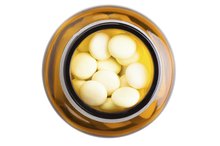What does fact checked mean?
At Healthfully, we strive to deliver objective content that is accurate and up-to-date. Our team periodically reviews articles in order to ensure content quality. The sources cited below consist of evidence from peer-reviewed journals, prominent medical organizations, academic associations, and government data.
- MedlinePlus: Para-aminobenzoic acid
- U.S. Food and Drug Administration: Guidance for Industry: A Food Labeling Guide (14. Appendix F: Calculate the Percent Daily Value for the Appropriate Nutrients)
- National Institutes of Health: Folate
The information contained on this site is for informational purposes only, and should not be used as a substitute for the advice of a professional health care provider. Please check with the appropriate physician regarding health questions and concerns. Although we strive to deliver accurate and up-to-date information, no guarantee to that effect is made.
Food Sources of PABA
Para-aminobenzoic acid is a substance sometimes referred to as vitamin Bx, according to the National Institutes for Health 13. While PABA is not a true vitamin, small amounts are usually present in B complex and multivitamins. The chemical structure of folate contains the compound PABA. Folate is an essential vitamin required for a healthy body. PABA is best known as the active ingredient in sunblock. In some cases, PABA is used in the treatment for various diseases of the connective tissue and skin.
Meats With PABA
While PABA is not vital for good health, it is found in various foods. Because PABA amounts are not listed on the food label, referring to folate or folic acid content in a food will let you know if it contains PABA. Most meats contain PABA, according to the Baptist Medical Center. Organ meats including liver and kidney are naturally good sources of PABA. A 1-ounce serving of pan-fried chicken liver contains 159 micrograms of folate, which contains PABA. As a comparison, the daily value used on food labels references 400 micrograms per day of folate based on a 2,000-calorie diet for adults and children 4 or more years of age.
- While PABA is not vital for good health, it is found in various foods.
- Because PABA amounts are not listed on the food label, referring to folate or folic acid content in a food will let you know if it contains PABA.
Grain Products
Foods High in Chromium Picolinate
Learn More
Grains, especially whole grains, contain PABA naturally. Industrially, folic acid, which contains PABA, is added to grain products including enriched breads, flours, rice, pasta, cornmeal and cereals. In the United States, the addition of folic acid is required, increasing folic acid intake by 190 micrograms per day since implementation in 1998. This likewise increased PABA intake.
- Grains, especially whole grains, contain PABA naturally.
- In the United States, the addition of folic acid is required, increasing folic acid intake by 190 micrograms per day since implementation in 1998.
Folate-Rich Vegetables
Mushrooms and spinach are a rich source of the substance PABA. Looking at folate content to compare the amount of PABA present in spinach, a 1-cup serving of boiled spinach contains 263 micrograms of folate. A 1-cup serving of mushrooms contains 69 milligrams of folate.
Other Foods
What Are the Benefits of Vitamin B-1 or Thiamine?
Learn More
Brewer's yeast, used in the making of beer, is an excellent source of PABA. High in protein and PABA, brewer's yeast also contains the vitamins thiamin, riboflavin and niacin. Molasses, which is the syrup remaining after sugar is crystallized out of beet or cane juice, is high in PABA. Wheat germ, another good source of PABA, can be sprinkled onto foods and entrees easily to increase your PABA intake.
- Brewer's yeast, used in the making of beer, is an excellent source of PABA.
- Wheat germ, another good source of PABA, can be sprinkled onto foods and entrees easily to increase your PABA intake.
Related Articles
References
- MedlinePlus: Para-aminobenzoic acid
- USDA: National Nutrient Database for Standard Reference
- National Institutes of Health: Folate
- Encyclopædia Britannica: Brewer’s Yeast
- Encyclopædia Britannica: Molasses
- 4-Aminobenzoic acid | C7H7NO2 - PubChem
- Growth of oriented p-aminobenzoic acid crystals by directional freezing
- 4-Aminobenzoic acid | C7H7NO2 - PubChem
- Folate Production by Probiotic Bacteria
- 4-Aminobenzoic acid | C7H7NO2 - PubChem
- Sunscreens And Photoprotection - StatPearls - NCBI Bookshelf
- Use of Flavonoids and Cinnamates, the Main Photoprotectors with Natural Origin
- Use of Flavonoids and Cinnamates, the Main Photoprotectors with Natural Origin
- Risk Assessment of Ethylhexyl Dimethyl PABA in Cosmetics
- Risk Assessment of Ethylhexyl Dimethyl PABA in Cosmetics
- Peyronie's disease: What's around the bend?
- Potassium paraaminobenzoate (POTABA) in the treatment of Peyronie's disease: a prospective, placebo-controlled, randomized study - PubMed
- [Pathophysiology and management of Peyronie's disease in adult patients: an update] - PubMed
- [Pathophysiology and management of Peyronie's disease in adult patients: an update] - PubMed
- Retrospective studies in scleroderma: skin response to potassium para-aminobenzoate therapy - PubMed
- Retrospective studies in scleroderma: skin response to potassium para-aminobenzoate therapy - PubMed
- Recent advances in understanding vitiligo
- Medication-Induced Repigmentation of Gray Hair: A Systematic Review - FullText - Skin Appendage Disorders 2020, Vol. 6, No. 1 - Karger Publishers
- CLINICAL ACHROMOTRICHIA - PubMed
- Darkening of gray hair during para-amino-benzoic acid therapy - PubMed
- Medication-Induced Repigmentation of Gray Hair: A Systematic Review - FullText - Skin Appendage Disorders 2020, Vol. 6, No. 1 - Karger Publishers
- Medication-Induced Repigmentation of Gray Hair: A Systematic Review - FullText - Skin Appendage Disorders 2020, Vol. 6, No. 1 - Karger Publishers
- Premature Graying of Hair: Review with Updates
- Sunscreen dermatitis: para-aminobenzoic acid and its derivatives - PubMed
- Allergic contact photodermatitis to para-aminobenzoic acid - PubMed
- Acute hepatitis associated with treatment of Peyronie's disease with potassium para-aminobenzoate (Potaba) - PubMed
- [Pathophysiology and management of Peyronie's disease in adult patients: an update] - PubMed
- Acute hepatitis associated with treatment of Peyronie's disease with potassium para-aminobenzoate (Potaba) - PubMed
- Antibacterial drugs - ScienceDirect
Writer Bio
Rebecca Slayton is a Registered Dietitian and has worked in the nutrition field since 2006. Slayton received the 2005 Betty Feezor Scholarship Award for her studies. She holds a Master of Science in food and nutrition from East Carolina University.









